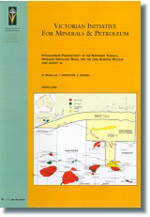VIMP Report 56 - Hydrocarbon prospectivity of the Northern Terrace, offshore Gippsland Basin, for the 1998 Acreage Release
 |
| |||||
Product description:Download The downloadable version of this report is supplied in PDF format. Executive Summary The offshore Gippsland Basin is a world-class oil and gas province. Major commercial oil and gas fields have been discovered in both structural and combined structural/stratigraphic traps, mostly within the upper part of the Latrobe Group. Many petroleum accumulations were also discovered at deeper stratigraphic levels within the Latrobe Group which comprises the Emperor and Golden Beach Subgroups, as well as the prominently coal-bearing Latrobe Siliciclastics (new subdivisions: A. Partridge in prep.). Area V98-1 was released in March 1998 by the Joint Authority in Commonwealth waters. Also to coincide with this release, Victoria released Area 98G-1(v) in the adjacent State's 3-mile-zone. The two blocks are located towards the northern extremity of the basin and lie to the east and southeast of the Lakes Entrance oil field. A number of undrilled prospects, leads and plays were identified by the previous operators of V98-1 and confirmed by the present study. The following is a summary of the hydrocarbon potential of these identified prospects, leads and new plays which are associated with the top and intra-Latrobe Group as well as the older part of the Latrobe Group (Golden Beach and Emperor Subgroups). Deep Latrobe Group Plays Kipper Extension Play (# 1): The play is confined between the Kipper and Judith faults. It is primarily the extension of the Kipper Field where non-marine reservoir sandstones of the Golden Beach Subgroup are sealed vertically by Campanian volcanics and both laterally and at the base by the Kipper Shale of the older Emperor Subgroup (Turonian). Drilling of Judith-1 demonstrated that these reservoir sandstones were only locally distributed. Similar Kipper-style traps, however, could be attractive if the combination of volcanic top seal and Kipper Shale (or Strzelecki Group?) in the upthrown block north of the Kipper Fault can be demonstrated. Emperor Subgroup Play (# 2): Significant rotation of intra-Emperor Subgroup fault blocks is evident on seismic data at a number of places along the northern basin margin. These fault blocks are caused by extensional faults extending from the Rosedale Fault to the north of the Judith Fault. In V98-1, the structures are fault-bounded to the north and south, and dip-closed to the east and west. The rotated blocks have the potential to contain hydrocarbons trapped in thick alluvial sandstones, which are sealed vertically by lacustrine shales and siltstones (“Kipper Shale”). Significantly, gas and oil (39.3 API) were recovered on RFT from thin sandstones near the base of this interval in Kipper-1. Judith-1 also demonstrated the deeper Emperor Subgroup play to be valid where significant gas shows were encountered at this level in thick alluvial fan sandstones. Intra-Latrobe Group Play Northwest Admiral Prospect (# 3): This prospect has been mapped at intra-T. lilliei level (Upper Campanian) and is partly controlled by down to basin faults. It is mostly located within adjacent VIC/P19. Additional seismic is needed to refine the mapping of this prospect. Top Latrobe Group Play West Flathead Prospect (# 4): This prospect is an anticlinal closure in the hanging wall of a major reverse fault and is associated with a Direct Hydrocarbon Indicator (DHI) supported by AVO (Amplitude-Versus-Offset) studies. The maximum area of prospect closure is 1.35 km2 with a vertical relief of 23 m, straddling the boundary between V98-1 and the Patricia/Baleen Retention Lease VIC/RL5. Gas-in-place has been estimated at 8Bcf (SECV, 1997). AVO analysis suggests that the gas could have spilled out in an updip direction. As the nature of the stratigraphic trapping element is uncertain, the gas accumulation could be larger. Updip Whale Prospect (# 5): This prospect lies updip of Whale-1 (which penetrated a 30 m residual oil column in the Latrobe and Strzelecki Groups) and is believed to contain a potential gas cap over the culmination of the Whale structure. The interpretation is based on a strong DHI supported by AVO studies. Estimated gas reserves in the Whale culmination are 11Bcf (SECV, 1997). Narwhal Lead (# 6): The trap in this lead is formed by the juxtaposition of a downthrown Latrobe Group reservoir against the sealing Palaeozoic basement across a major fault. The lead covers an area of some 7 km2 with a vertical closure of 50 m giving the potential for an accumulation of over 20Mstb oil. Stratigraphic Pinchout Play (# 7 ): This play has possibly a very large areal extent and has the potential for several million barrels of oil. It is recognised at the depositional edge of the Latrobe Group in V98-1 and should be present in 98G-1(v). The play is formed by the pinchout of Latrobe Group sediments onto the basement of the Northern Platform. Bibliographic reference Megallaa, M., Bernecker, T. and Frankel, E., 1998. Hydrocarbon prospectivity of the Northern Terrace, offshore Gippsland Basin, for the 1998 Acreage Release. Victorian Initiative for Minerals and Petroleum Report 56. Department of Natural Resources and Environment. | ||||||

